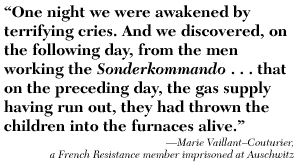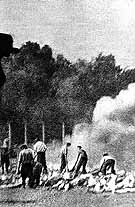
|
|
|

|

|

|

|
|
Click on an image to see a larger, more detailed picture.
|
|
|
|
|
| 1942: The "Final Solution" |

|
pg. 378 |

|
|
|
|
| |

|
 This chart outlines the appropriate forms of communication to be sent with each rail deportation of Jews. Coordinating the "Final Solution" was a tremendous logistical operation. Scheduling trains, selecting individuals for deportation, and determining where to send each shipment required a complex and sophisticated bureaucracy. It was important, therefore, to standardize the forms used to detail the shipping information that accompanied every train sent to a Nazi concentration camp or extermination center.
This chart outlines the appropriate forms of communication to be sent with each rail deportation of Jews. Coordinating the "Final Solution" was a tremendous logistical operation. Scheduling trains, selecting individuals for deportation, and determining where to send each shipment required a complex and sophisticated bureaucracy. It was important, therefore, to standardize the forms used to detail the shipping information that accompanied every train sent to a Nazi concentration camp or extermination center.
Photo: Main Commission for the Investigation of Nazi War Crimes / United States Holocaust Memorial Museum Photo Archive
|
 Members of a Sonderkommando (special unit) burn the bodies of victims gassed at Auschwitz-Birkenau. Selected from among the prisoners, the Sonderkommando had to perform especially onerous tasks, including searching the dead for valuables, moving bodies to the crematoria or open pits, and cleaning the gas chambers. They received better housing and food, but these were short-lived privileges since the Sonderkommando members were gassed and replaced at regular intervals.
Members of a Sonderkommando (special unit) burn the bodies of victims gassed at Auschwitz-Birkenau. Selected from among the prisoners, the Sonderkommando had to perform especially onerous tasks, including searching the dead for valuables, moving bodies to the crematoria or open pits, and cleaning the gas chambers. They received better housing and food, but these were short-lived privileges since the Sonderkommando members were gassed and replaced at regular intervals.
Photo: SYddeutscher Verlag Bilderdienst
|
|

|

|

|

|
 October 11-12, 1942: Eleven thousand Jews from Ostrowiec-Swietokrzyski, Poland, are killed at the Treblinka death camp.
October 11-12, 1942: Eleven thousand Jews from Ostrowiec-Swietokrzyski, Poland, are killed at the Treblinka death camp.
|
 October 15-21, 1942: An SS Aktion is undertaken against Jews of Piotrków Trybunalski, Poland. Many are shot in their homes and 22,000 are deported to the Treblinka death camp.
October 15-21, 1942: An SS Aktion is undertaken against Jews of Piotrków Trybunalski, Poland. Many are shot in their homes and 22,000 are deported to the Treblinka death camp.
|
 October 15, 1942: 25,000 Jews of Brest-Litovsk, Belorussia, are murdered. Jewish resistance, led by Hana Ginsberg, attempts to fight back.
October 15, 1942: 25,000 Jews of Brest-Litovsk, Belorussia, are murdered. Jewish resistance, led by Hana Ginsberg, attempts to fight back.
|
|
|
|
|
| 1942: The "Final Solution" |

|
pg. 378 |

|
|
The Holocaust Chronicle
© 2009 Publications International, Ltd.
|
|
